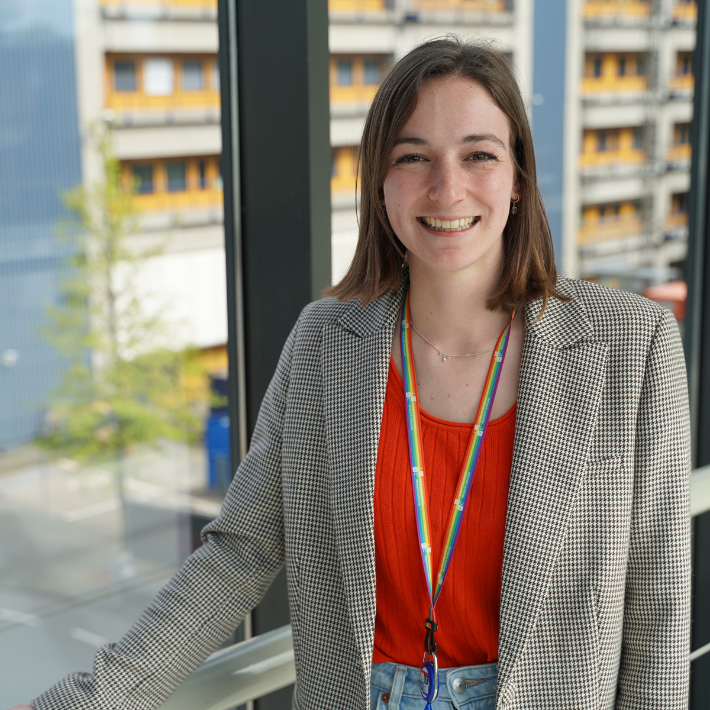Video reflection in the hospital (without lecturing each other): here's how to do it
PhD researcher Veerle Heesters.
&w=710&h=710)
It started ten years ago with a camera above a cot. Heesters: “That was still without sound and only the hands of the healthcare providers were shown. At a certain point the team started looking back at the images together. This made employees think more consciously about actions and stick better to guidelines.”
In the following years, the department began to expand filming. “By now there is also a camera hanging on the wall that captures the entire room and also records sound. We also started filming with special glasses - giving you a point of view shot - which records what the wearer sees and hears. In addition, it is now so extensive that caregivers are recognizable in the picture,” she says.
The neonatal intensive care unit treats premature babies and sick newborns who need intensive care after birth. The department films operations such as the care of a baby immediately after birth and acute procedures such as intubation (the insertion of a breathing tube).
Privacy, security and vulnerability
An important requirement in filming is privacy. Caregivers must give permission to be filmed at each time and use the footage for a team discussion. After a discussion, the footage is always deleted.
Video sessions take place at a later time. The doctors and nurses involved, together with the rest of the team, watch back a pre-selected part from the video recording and discuss the images. This requires a certain vulnerability on the part of colleagues. “That's why it's important to have a safe environment,” says Heesters. “We have established feedback rules and for each session we appoint a chairperson to lead the discussion.” Because suppose, a heated discussion arises, someone is always there to guide it.”
A video session (the department calls it, with a wink, Neoflix: a contraction of neonatology and Netflix) gives a care worker the opportunity to discuss something from daily practice and possibly improve or change it. Video reflection is designed to allow employees to learn from each other, not lecture each other.
Recall bias
For her doctoral research, Heesters did a lot of qualitative research on video reflection in the neonatology department at LUMC. This showed, for example, that the sessions led to improvements in guidelines and protocols, tips and tricks for performing procedures, developments in training and education, and input for research.
During the study, Heesters interviewed physicians and nurses about the use of Neoflix. “One thing that came out of that was that, in the beginning, you have to get a team used to video reflection in particular. Hence, have caregivers first attend some feedback sessions before they start recording themselves,” the doctoral student said.
Additionally, her research uncovers that caregivers remember things differently after treatment than how they actually went. In science, this well-known phenomenon is known as recall bias. “At emergency situations, everyone is so busy doing their own task that people do not always realize what is going on around them. Documentation based on memories is then not sufficient, whereas with video you can reflect really well,” says Heesters.
No off-the-shelf package
The use of video reflection in LUMC's neonatology department has attracted the attention of other departments and hospitals. “They regularly visit us to see how we do it. Usually everyone is excited right away. Next, they want to know how they can introduce video reflection in their department. On top of that, they have all kinds of practical questions,” Heesters says.
To answer these questions, Heesters developed a toolbox, which can be consulted by anyone. The toolbox provides tools for departments and hospitals to get started with video reflection. It includes very practical tips, such as how to start filming. On the website, the neonatology team also shares their own experiences about using video reflection. In addition, the website offers information on how to deal with privacy and security, among other things.
The toolbox is not a ready-made package. On purpose it isn't. In fact, the idea is that departments can give their own interpretation to the concept. Heesters: “We find it very important that the toolbox is accessible to everyone. Anywhere in the world. Suppose you have few financial resources, but you do have a camera, you would already have enough to start with video reflection.”
No need to reinvent the wheel yourself
Lastly, the toolbox also provides an opportunity for facilities that use video reflection to connect with each other and exchange information. Departments from different hospitals can also hold joint video sessions, for example, as the neonatology department is already doing with colleagues from a hospital in Vienna. The (international) sharing of information between medical institutions, according to Heesters, is entirely in keeping with this era of openness and transparency. “Instead of everyone reinventing the wheel themselves,” she say